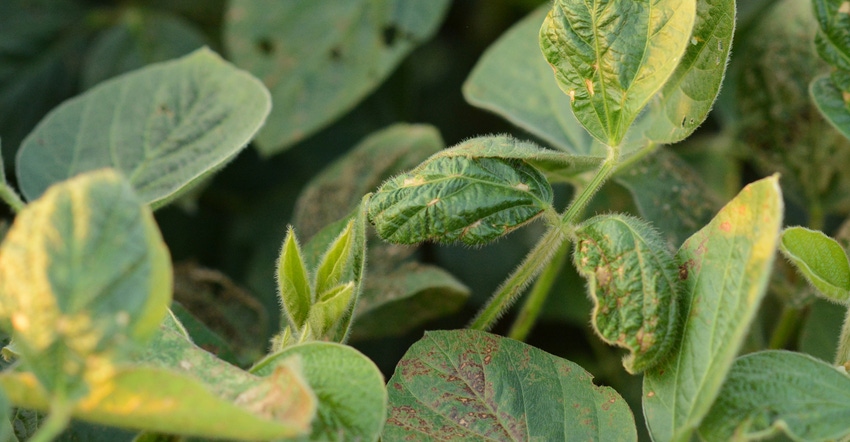
As the 2020 growing season approaches, the Illinois Department of Agriculture says it’s yet to resolve about 200 dicamba-related drift complaints out of the more than 700 it received for the 2019 growing season. Of the 500 or so cases that have been investigated and resolved, about 100 resulted in fines.
According to Jean Payne, Illinois Fertilizer and Chemical Association president, some commercial applicators and private applicators who’ve already received violations have begun the process of contesting the complaints, promising a lengthy process as government offices shutter due to COVID-19.
“The 2019 season — in particular, the administrative hearing process — could go well on into 2021,” Payne says.
More monetary penalties were handed out for 2019 violations, compared to just a handful in 2018.
“The seriousness of this is ratcheting up. And I think the goal of the whole Department of Ag is to get these numbers down in 2020,” Payne says, noting there was a never-before-seen spike in “knowing” violations for dicamba applications made in 2019. This type of violation racks up enough points to kick in an automatic-penalty minimum fine of $750.
Severe penalties for applicators who get a high number of points for applying after the cutoff date and forging records can go up to $10,000. But 80% of the fines sent out so far in 2020 for 2019 stayed at the lowest level of $750. The rest reached $1,000.
“They’re kind of sending a message with penalties this year to private and commercial applicators saying, ‘We’re continuing to come out. We’re continuing to see symptomology, and if we determine there are record-keeping errors and wind speed or direction violations, IDOA is not going to just give you a warning letter anymore. Now it’s a monetary penalty,’” she says.
There have been four advisory and 13 warning letters sent out so far in 2020. Following complaint investigations, IDOA uses a point system to determine penalties. A “knowing” degree of responsibility adds 10 points to the misuse finding, and if an applicator is found in violation again in 2020, 5 points will be carried over from their 2019 penalty determination. That will put any 2020 misuse findings into monetary penalty territory again.
“Seven to 13 points corresponds to a warning letter penalty; 14 to 16 points corresponds to a $750 fine,” says Doug Owens, chief of the Bureau of Environmental Programs. “The higher the point value, the higher the level of the penalty.”
A knowing violation often follows warnings from the prior year and opens the door to the recovery of damages. A plaintiff grower might use the public record of a knowing violation, or even a negligent violation, as the basis for a civil case or an insurance claim.
Owens notes more than 90% of the 720 dicamba-related complaints IDOA received were from soybean growers.
The rules
In addition to in-person trainings, dicamba training has been offered online this year. It appears more applicators are opting for online training, which explains why a training session held in early March only had seven attendants.
“It’s just a sign of the times. More people are comfortable with online training, especially after they’ve been through the classroom in prior years,” Payne says.
Training ensures applicators are compliant with rules that change year to year, she says. This includes the dicamba application cutoff that takes place 45 days after planting soybeans or June 20, whichever is sooner. For the 2020 growing season, farmers must also go to weather.gov and type in the ZIP code of their field. If the temperature is forecast at 86 degrees F during that day, they can’t apply.
“Even if it’s only 78 degrees and it’s 7 a.m., you can’t apply for the entire day if the forecast is 86 or higher,” Payne says, adding the rule is intended to limit volatilization, though new research published in October indicates that dicamba can volatilize days after application.
The COVID-19 outbreak has interfered with the last of the scheduled training sessions in Illinois. In response, IDOA is extending expiring pesticide licenses for one year at no fee. Payne says applicators and handlers who still need the required training for dicamba are to use online resources.
IDOA issued an FAQ on March 23 explaining how pesticide license issues will be addressed during the virus management period.
Good stewardship
Dicamba has been used for over 50 years, but Payne says the way it’s being used today requires more management. She advises those who use the herbicide on corn to talk with neighbors and ensure that neighboring soybeans are dicamba-tolerant, just as anyone using a trait system should do.
“Enlist and Liberty are not tolerant to dicamba. And the Xtend beans are susceptible to 2,4-D. And the Liberty beans are susceptible to 2,4-D and dicamba. And the non-GMO beans are susceptible to all auxin herbicides,” Payne says. “We have four different soybean platforms, and none of them really coexist, at least for now, so the communication between farmers and retailers in 2020 is important.”
There is a new feature in the FieldWatch program at cropcheck.org where growers can volunteer to register what soybean traits they have planted. Prior to applying dicamba to soybeans, applicators are required to check FieldWatch for sensitive specialty crops, which includes organic soybeans.
Payne says the growers who hire commercial applicators must help the applicator by communicating with neighboring growers and report to the applicator the traits that are planted next to their Xtend fields.
“We had cases this year where everybody thought the neighbor’s beans were going to be tolerant and found out later that someone changed their mind at the last minute, planted a variety that was vulnerable to dicamba, and forgot to tell somebody,” Payne says. “The applicator pays the price for that. Communication is going to be key in 2020 if we want to bring complaints down.”
About the Author(s)
You May Also Like




